Heading out the door? Read this article on the new Outside+ app available now on iOS devices for members! Download the app.
If you haven’t reached for a medicine ball in a while, consider this a sign that it’s time to add it into rotation — especially for your abs.
“Although its intended purpose is for throwing, the med ball gained popularity in the functional fitness space and I’d even go as far as saying it became even more coveted at the beginning of the pandemic as dumbbells and kettlebells became scarce, says Lalaina “Lala” Duncan, a strength coach at New York City’s training gym Dogpound, where she has trained Olympic and professional athletes. “Because med balls come in a variety of weights and sizes and can easily be used to build strength as well as used for conditioning, it’s a great training tool for people of all fitness levels.”
So how does this tie into six-pack abs? Abs are just like every other muscle in the body and need to be trained with resistance. And that’s where the medicine ball comes in, as Duncan says it’s a safer alternative to traditional dumbbells and kettlebells.
“If abs are made in the kitchen, the core is built in the gym,” she says. “No matter where movement starts, it travels upwards and downwards to adjoining extremities in the body. If your core is weak, it can drastically affect how well your arms and legs move and is ultimately responsible for keeping your back and spine safe from pain and injury. A strong core enhances power, balance and stability and overall enhances quality of life.”
Are you ready to rock these six medicine ball exercises for six-pack abs? Here’s exactly what you need to do:
6 Medicine Ball Exercises for Six-Pack Abs
1. Knee-In With Medicine Ball
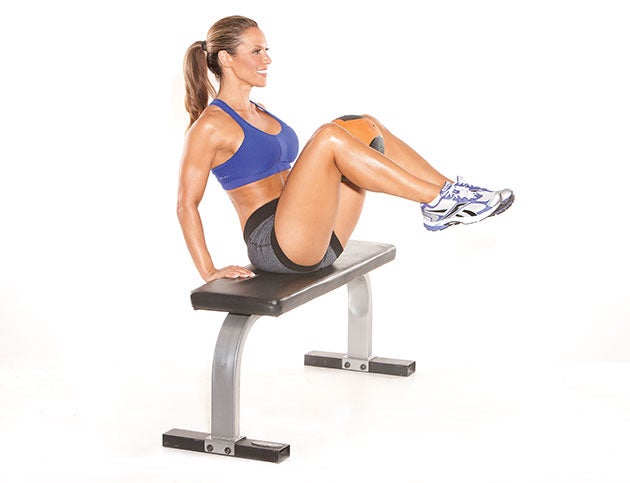
Sit on a bench with a medicine ball between your knees; touch your feet together to form a diamond shape with your legs. Holding the bench for support, lift your legs from the ground and lean back slightly. Bring the ball towards your chest by bending your legs; at the same time, hinge forward slightly from your hips. Extend to return to the start, and repeat for two to three sets of 10 to 15 reps.
Make It Easier: Ditch the med ball, keep your feet together and splay your knees to the sides.
Crank It Up: Duncan suggests trying the “Look ma, no hands!” approach, as it will have your stabilizers working overtime.
2. Bicycle With Weave
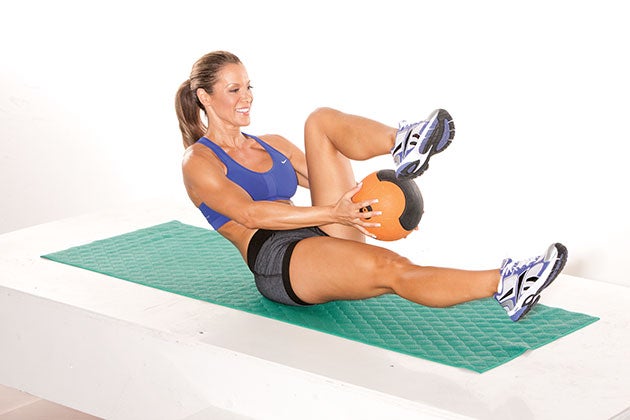
Hold a medicine ball in your left hand and sit on a mat with your feet lifted from the floor as shown. Bend your right knee, bringing it towards your chest, and pass the ball under the right leg. Grab the ball with your right hand, then switch leg positions and reverse the move to return to the start. Continue fluidly for 30 seconds, then rest and repeat once more. Be patient: the move might be tricky the first time, but with a bit of practice, you will eventually be able to do it seamlessly.
Make It Easier: Cut out the pass (just cycle your legs).
Crank It Up: “When going heavier isn’t a viable option, try increasing the speed,” says Duncan. “Once you’ve mastered this movement, go AMRAP (as many rounds as possible) until you either drop the ball or form breaks down.”
3. Med-Ball Hip Lift
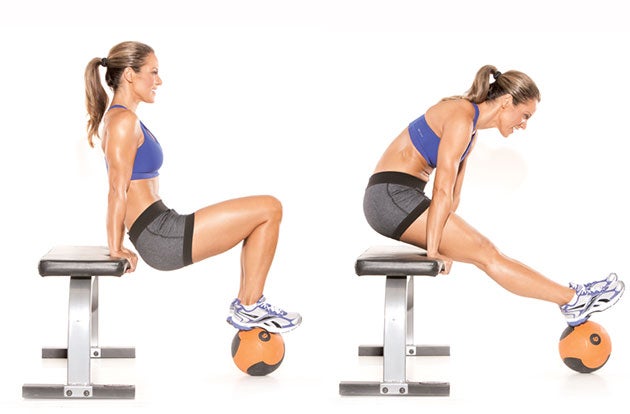
Sit on a bench, gripping the edge on each side of your hips for support, and place both feet on a medicine ball, with knees bent. Contract your core, straighten your legs and lift your hips rearward to roll the ball away from the bench; your tailbone should be directed towards the wall behind you at the top of the move. Pause, then release and return to the start. Repeat for two sets of 10 reps.
Make It Easier: Only focus on lifting your hips straight up from the bench.
Crank It Up: “As if this one isn’t challenging enough, try lifting one foot off the ball once you’ve lifted your hips and hold for a three-count,” suggests Duncan. “Then repat on the other side and do 10 reps.”
4. Med-Ball Roll-Up
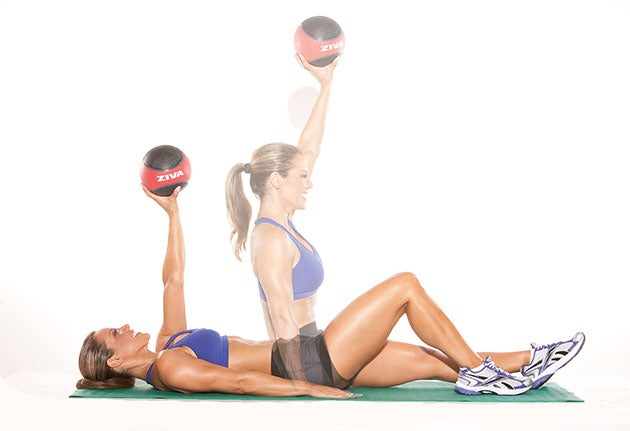
Lie faceup on an exercise mat, with your left leg straight and your right leg bent (foot flat on the floor). Hold a light medicine ball in your left hand and extend your arm towards the ceiling. Keeping your arm straight, roll your spine up from the mat, vertebrae by vertebrae, until you are in an upright position. Slowly reverse to return to the start. Perform two to three sets of five to eight reps, then repeat on your other side.
Make It Easier: Do the exercise without the med ball and keep both legs straight.
Crank It Up: “Try keeping both legs firmly pressed against the floor and not allowing the heels to come up,” says Duncan. “You’ll see really quick how important it is to have a strong and flexible core.”
5. V-Up With Med-Ball Pass
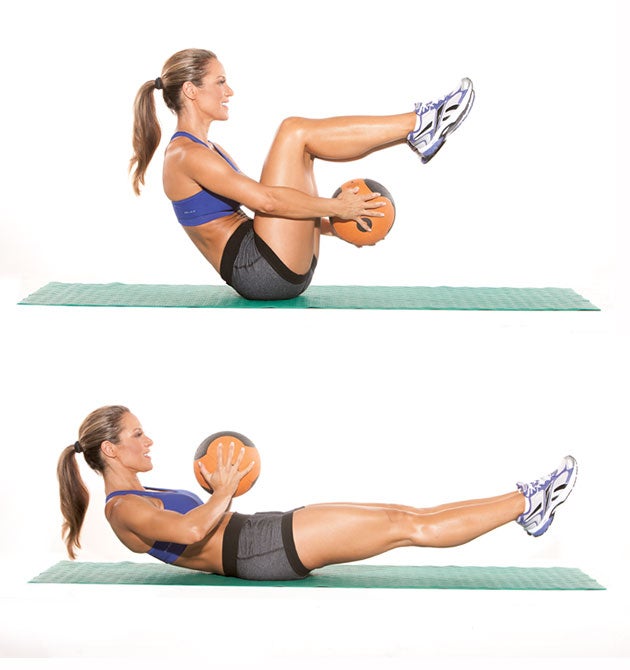
Lie faceup on a mat and hold a medicine ball with both hands. Flex your hips to lift your torso from the floor and bend your knees, bringing them towards your chest; concentrate on “scooping” your abdominal wall as you rise. With your body in a “V” position, pass the ball behind your thighs from your right hand to your left. Extend your legs to return to the start, then reverse the pass on your next rep. Do two sets of 10 reps in each direction.
Make It Easier: Touch your hands under your legs instead of passing a ball.
Crank It Up: Once you’ve mastered the med-ball pass, add another layer to the movement. “Try going one rep where the ball goes behind the head and touches the toes, then the second rep is a med ball pass,” says Duncan. “And double time it!”
6. Seated Med-Ball Twist
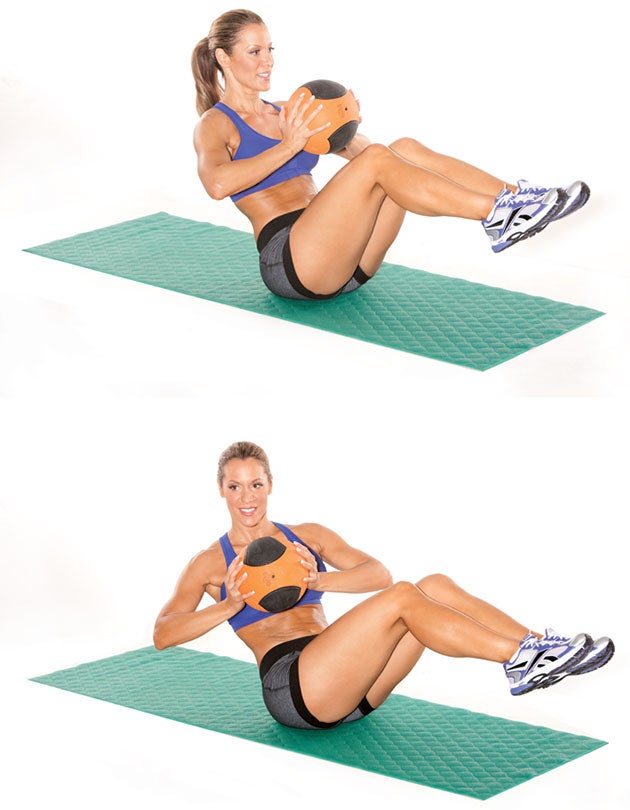
Sit on a mat with your legs bent and feet on the floor. Hold a medicine ball close to your chest, lift your feet from the ground and lean back slightly from your hips. Alternate rotating your torso from left to right. Do two 30-second sets.
Make It Easier: Plant your feet on the ground (shown), or remove the weighted ball and hold your hands in front of your chest instead.
Crank It Up: Rotation is key when it comes to training the muscles of the core. “While seated twists are commonly used for training the obliques, I would say a more advanced and more functional movement would be a half-kneeling low to high chop using a med ball,” says Duncan. “Focus on slow and controlled movement, with three seconds up and three seconds down, rotating using only the obliques.”
We independently source all of the products that we feature on oxygenmag.com. If you buy from the links on our site, we may receive an affiliate commission, which in turn supports our work.